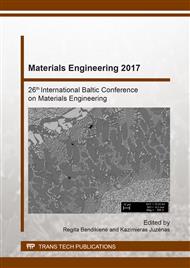p.58
p.63
p.68
p.76
p.82
p.87
p.93
p.98
p.103
Technological Peculiarities of Chromium Carbide-Based Iron Alloy Bonded Cermet
Abstract:
Cr3C2-Ni cermets exhibit high hardness and excellent corrosion, oxidation, abrasive and erosion resistance. However, nickel is toxic and carcinogen and because of that great efforts were made to displace or replace nickel in the composition of cermets. Therefore, in the present research chromium carbide-based cermets with FeCr-type ferritic binder was fabricated and investigated. Composites were sintered at different conditions: vacuum and spark plasma sintering. Spark plasma sintered cermets demonstrated acceptable structure and mechanical characteristics. Chemical composition of chromium carbide-based iron alloy bonded cermets was analyzed by energy-dispersive X-ray spectroscopy and structural analysis was carried out using X-ray diffraction. Sintered cermet consists of two main phases: α-Fe and (Cr,Fe)7C3 complex dicarbide. Mechanical characterizations – hardness and fracture toughness – was performed. Also oxidation rates were determined.
Info:
Periodical:
Pages:
82-86
Citation:
Online since:
October 2017
Authors:
Price:
Сopyright:
© 2017 Trans Tech Publications Ltd. All Rights Reserved
Share:
Citation:


